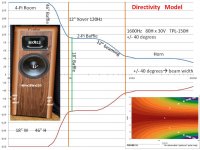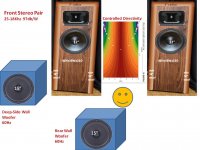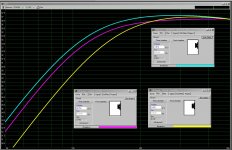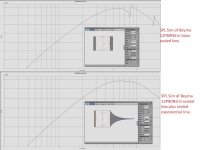I think those are internal braces for the speaker. 😀
The speakers look pretty awesome to me even without 60 drivers though.
-Chris
Stiffening braces.
You would be quite surprised the amount of pressure generated inside a folded horn.
If you add up the path length you can guess at the horns Fs.
Nice a low, nice and efficient.
Just like the Doctor ordered!
These were shown here:
Funk Audio and Friends | Stereophile.com
[http://forums.stevehoffman.tv/threads/rocky-mountain-audio-fest-2013-anyone-here-going-this-year.327843/page-6#post-9519573"]Rocky Mountain Audio Fest 2013 - Anyone here going this year?
Our report: Funk Audio speakers and David Berning amplifiers on RMAF 2013 | Ultimist
Mark: these speakers are gorgeous.
Technical spec are really impressive. Which kind of filter is used?
Well if I told you I'd have to shoot you!
Let's say it like this.
Careful attention to detail was used.
Attention to what the filters do in the passband and at the crossover points.
Some were steep.
Some were not.
There was a little EQ used in the low end, and a high pass filter of course because a horn can indeed unload very abruptly. And in fact at the show two tracks that I had could driver the speaker into that situation. A problem since remedied.
Back when I worked on that filter set I did not have access to DSP with FIR filter sets. I do now. So This has gotten better not worse.
Placement of the drivers in relation to the horn throat has also been optimized to get an even more robust output from the driver complement.
They are custom production pieces.
And are available on request.
Next set will be with my own drivers. A few things up my sleeve with those to. Like double the x-max etc.
I prefer a driver with a large enough coil to keep the cone rigid. So most of my driver designs use a 50 mm coil former or larger. Even on my 5.25 inch driver.
Extensive use of shorting rings and custom moving assemblies are a bit of help to.
Onward and upward.
Anyway. I've hijacked this thread enough.
I think Greg ( GM ) has hit the nail on the head in regards to the bass situation.
You most likely have a null where your present listening position and speaker positions are. You might try loading the room from the end where the window is. That might be the ticket. I have found that if one long wall position is a dead loss, then usually loading the room from the short wall will be the point of gain in terms of bass.
Well if I told you I'd have to shoot you!
You could try but i'm far...far away from you! 😉
Thank you for the infos. I'm curious about the driver layout because i've not heard many loudspeakers using this kind of configuration which was 'good' to my ears. Except a Dunlavy in fact most seemed to fail to me (my taste)...
It was the reason i asked about the picture with the tiny girl (or large speakers) Linesource posted which look like an Horbach/Keele (fir used to control vertical directivity) layout. I understand your horn loading induce particular needs.
I agree about the null and overall change in speaker layout in room. It will be easier to deal with the ceiling too, to have a kind of 'symmetric' response for ER.
You could try but i'm far...far away from you! 😉
Thank you for the infos. I'm curious about the driver layout because i've not heard many loudspeakers using this kind of configuration which was 'good' to my ears. Except a Dunlavy in fact most seemed to fail to me (my taste)...
It was the reason i asked about the picture with the tiny girl (or large speakers) Linesource posted which look like an Horbach/Keele (fir used to control vertical directivity) layout. I understand your horn loading induce particular needs.
I agree about the null and overall change in speaker layout in room. It will be easier to deal with the ceiling too, to have a kind of 'symmetric' response for ER.
To much talking has been applied to filter types as being the best.
Without a practical application there is no perfect type of filter.
And in an application where you are trying to steer the dispersion patterns from all the drivers to a point in space that you choose, you need to do a lot of work to get it right.
One of the reviewers was most correct when he stated that our placement did not give the speakers their best chance at imaging.
Small rooms and limited options are what we were up against.
The great thing with using DSP is that we could tailor the response of the the speaker to a very defined curve that I find to be of greatest use when listening to music. A dead flat curve is the last thing you want.
And where you choose to setup your mic to measure your speakers is of the utmost importance.
P.S.
France, Canada, Not that far. Heheheh
A dead flat curve is the last thing you want.
I'm a long time converted to that (spent too much time in control room with tad driver/horns... straight this combo is awful!!!). I start to filter my speaker at 1.1khz using -1.5db/octave to the highest my hifreq driver reach (and my dsp allow!).
France, Canada, Not that far. Heheheh
Well it depend on weapon you choose... but i should have a cause for concern when i see your loudspeakers! 🙂
Last edited:
I'm a long time converted to that (spent too much time in control room with tad driver/horns... straight this combo is awful!!!). I start to filter my speaker at 1.1khz using -1.5db/octave to the highest my hifreq driver reach (and my dsp allow!).
Well it depend on weapon you choose... but i should have a cause for concern when i see your loudspeakers! 🙂

Be happy I am on your side!

😀
OT: Chris check your mails... you have readings waiting for you.
I've been reading through it all and reading through it all again for the last two hours. Thank you so much for going through the trouble of modeling and explaining what the graphs you sent mean.
As I mentioned in my quick email reply a few minutes ago I can see just what you describe when looking at the polar maps but I'm having a little trouble grasping what I'm looking at with the polar plots. I can see they are quite different between the different simulations but the visual of what is happening at different frequencies and degrees off the direct axis just isn't coming to me yet.
But I'll work on that.
This is embarrassing to admit but the sims and descriptions you sent made something click into place for me. And that is why off axis response matters even when I'm listening directly in line with the drivers. It just hadn't hit me that it may not sound quite right if the reflected waves I hear have a greatly different frequency response compared to the sound I hear coming directly from the speaker, and to each other depending on the angles.
I was also assuming that I would be able to increase the low pass frequency later if I wanted to run the mid bass modules a little higher. Seeing the simulation showing problems starting a little over 400 Hz with my vertically stacked drivers was a huge help to understanding that was a bad assumption.
What software did you use for the simulations you did? I've been thinking about paying the $250 for Sound Easy. I'm sure this is not the last speaker project I'll attempt. But the reviews make it sound really difficult to understand and use. If you need a physics degree to use it I'll just spend the money on components and spend time learning to use some of the free software out there.
-Chris
What software did you use for the simulations you did? I've been thinking about paying the $250 for Sound Easy. I'm sure this is not the last speaker project I'll attempt. But the reviews make it sound really difficult to understand and use. If you need a physics degree to use it I'll just spend the money on components and spend time learning to use some of the free software out there.
REW is free.
And you can take pretty good measurements with it. Actually you can take really good measurements with it.
ARTA is also free and very good to use.
Hornresp can model almost any type of speaker you can think up.
It has a bit of a learning curve, but there are plenty of guys who are willing to walk you through it on the forum.
I also posted a very thorough opensource acoustics modeling program for you if you are interested.
The days of having to pay lots of money to have good quality tests are behind us.
You have an odd shaped room without significant investment in room treatments. Your preliminary room modeling should illustrate issues with early reflections which garble up the sound stage, and resonances from multiple low frequency room modes. Your preliminary modeling should also illustrate that bass room modes are best corrected with proper positioning of multiple subwoofers below 60Hz. MASSIVE amounts of absorption material is usually less effective treatment.
"Directivity in Loudspeaker Systems" is an excellent white paper by Dr. Geddes discussing the importance of controlled directivity speakers, and how speaker designs using horns/waveguides can help to optimize the listener's soundstage by reducing early reflections, and directing high-to-mid frequencies to the listeners instead of to the walls.
http://www.gedlee.com/downloads/directivity.pdf
Geddes presentations on low frequency sound advantages from using several 60Hz woofers at key room placements.
www.gedlee.com/downloads/OptimalBassPlaybackinSmallRooms.pptx
========
Crossovers are evil, especially in the 100-1100Hz vocal range. Phase Shift. Tone shift. Time-Transient shift. Evil.
Model the low cost Eminence DeltaPro 12A, medium cost Faital 12FH520, and Legendary Acoustic Elegance TD10M + TD12M for a vocal range midbass. Model solving the bass modes in your room using stereo-pair of Controlled Directivity 3-way in front speakers covering 25-18Khz range, PLUS your current two 15" subwoofers with 60Hz crossovers positioned on rear+side walls to reduce room modes. Experimental data shows 60Hz is highest "unable to physicallly locate" woofer crossover frequency, and 80Hz is "hard to physically locate" . Sealed midbass alignments deliver superior transient response. Sealed volume with stuffed tapered tube offers rare smooth dynamics.
"Directivity in Loudspeaker Systems" is an excellent white paper by Dr. Geddes discussing the importance of controlled directivity speakers, and how speaker designs using horns/waveguides can help to optimize the listener's soundstage by reducing early reflections, and directing high-to-mid frequencies to the listeners instead of to the walls.
http://www.gedlee.com/downloads/directivity.pdf
Geddes presentations on low frequency sound advantages from using several 60Hz woofers at key room placements.
www.gedlee.com/downloads/OptimalBassPlaybackinSmallRooms.pptx
========
Crossovers are evil, especially in the 100-1100Hz vocal range. Phase Shift. Tone shift. Time-Transient shift. Evil.
Model the low cost Eminence DeltaPro 12A, medium cost Faital 12FH520, and Legendary Acoustic Elegance TD10M + TD12M for a vocal range midbass. Model solving the bass modes in your room using stereo-pair of Controlled Directivity 3-way in front speakers covering 25-18Khz range, PLUS your current two 15" subwoofers with 60Hz crossovers positioned on rear+side walls to reduce room modes. Experimental data shows 60Hz is highest "unable to physicallly locate" woofer crossover frequency, and 80Hz is "hard to physically locate" . Sealed midbass alignments deliver superior transient response. Sealed volume with stuffed tapered tube offers rare smooth dynamics.
Attachments
The great thing with using DSP is that we could tailor the response of the the speaker to a very defined curve that I find to be of greatest use when listening to music. A dead flat curve is the last thing you want.
I was thinking about this, and the discussion in the subwoofer thread, earlier today.
The more I think about it, the more I want to break it down into two separate categories. I'm sure there are better names but I think there is a big difference between producing sound and re-producing sound.
If you are setting up speakers for a live performance then a flat frequency response across our hearing range would sound terrible, I'm sure. If for no other reason than our ears having different sensitivities at different frequencies and even that curve changing with SPL.
But when re-producing recorded sound, I just can't see how such a blanket statement as "A dead flat curve is the last thing you want" can be such a sure thing. To me, what you want for playing back recorded audio it is extremely dependent on who does the recording/mixing/mastering. It all depends on the knowledge, taste, equipment and effort put in by whoever does the recording and mastering. In my opinion, any producer with real talent will understand that flat doesn't sound good and account for that in the recording.
The best example I have is long running bands with multiple different greatest hits releases. The exact same song can be, and commonly is from my experience, remastered with different frequency ranges emphasized in each release. There are some good examples with different releases of The Eagles songs and Eric Clapton but the most extreme example I have is with some Stanlet Clark stuff I have in Spotify. I have multiple albums with the same songs mastered in very different ways, mostly in the bass levels.
So how do you deal with this when re-producing recorded sound? A setup that isn't flat will actually make recordings from the most talented and knowledgeable producers sound bad compared to recordings from lesser producers that just happened to pair well with the coloration you purposely built into your playback system.
Living in the Nashville area you can't throw a rock without hitting a musician or producer. I've met a few and I don't think a single one of them would consider all of this when putting their art on a CD. Even if they did, what would they do about it? Master the music for a certain brand and model of speakers?
Isn't this the reason studio headphones and monitors are pretty flat? If the recording sounds good on the common equipment used for mastering then the frequency curves to make it sound good should already be there for a flat playback system to reproduce and make sound good.
Where am I off with this line of thinking?
-Chris
Last edited:
I prefer a driver with a large enough coil to keep the cone rigid. So most of my driver designs use a 50 mm coil former or larger. Even on my 5.25 inch driver.
I like that approach. In fact since I heard soem Dynaudios for the first time I was hooked on that although they don't belong to the high efficiency camp.
OTOH I have to admit that my latest 12" midrange has only a 3" voice coil. I would have preferred one with a 4" one but did not want to go with a 12p80nd.
Regards
Charles
It is indeed.
A real party animal.
500 watts to the tweeter, with proper limiter of course.
500 to the mids, again with a limiter.
1200 watts to the woofers.
Lets say that the amps never even break a sweat.
I listened to a private recording of fireworks on this pair. Used to be available from Tom Danley's site.
It was one interesting experience.
Now we are hijacking iScreams thread but those marani amps idles very few watts!!
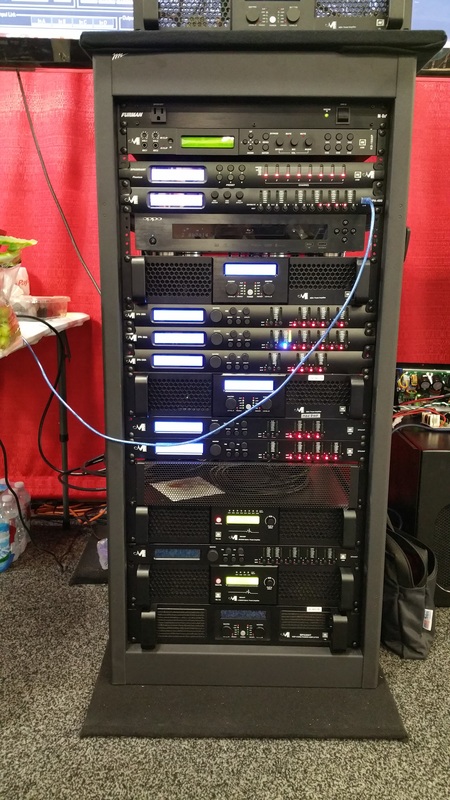
can you provide some REW distortion graphs (if you´re familiar with REW) from that 8" faital speaker?
Allways nice to see some graphs
Last edited:
Where am I off with this line of thinking?
First in thinking that studio headphones and monitors are flat. This isn't the case. I don't know from where do this thing came (well in fact i know... 🙂 ) but this is a myth.
For main monitors in recording/mixing studios (the big ones, flush mounted into the wall) there is always an in 'house curve' to correctly adapt them to the room (an eq or processor). For nearfield monitors you can judge by yourself if Auratone or Yamaha NS10 are flat by downloading the user manual of the 'bigger model' of Barefoot monitors and look at the simulated mode for this two widespread nearfield monitors. I think you won't think this kind of flat! 😉
Here is my point of view about the 'flat' fr from pro gear: to make a correct comparison point between different models from differents manufacturer you need a 'view' on them which take out of equation the acoustic of room (as this highly modify the fr of loudspeakers). So to do this you need an anechoic chamber set of measure. In this case to be able to compare them let's say manufacturer target 'flat' response because it's easier to compare.
But once you have sold a set of speaker and installed them in room i can guarantee you that you need to taylor theyr response to the room! You won't support more than 10min of flat reproduction in any control room at 90dbspl... It's painfull! And this is the reason most studio monitors are comissionned with an acoustician using many test equipment to install them...
And when they don't are commisionned you'll have some kind of eq included to the speaker to adpat them to your listening space (with powered one at least).
If for no other reason than our ears having different sensitivities at different frequencies and even that curve changing with SPL.
Yes but it is not the whole story. Think about wavelength of very high frequency. Do you think than moving through a viscous medium won't affect them? 🙂
Air is a kind of sound absorber for high frequency... think about it! Air is not transparent: talk about any PA engineer which has do deal with live event at sunset after a long sunny summer day... It 'll explain you some strange behavior of air refreshing and sound... acting a bit like a mirror for high end... 🙂
I just can't see how such a blanket statement as "A dead flat curve is the last thing you want" can be such a sure thing.
Sorry about that but it is. At least from my point of view but as i can see for others too! 😉
Mastering is a whole subject on itself... i could talk about it but it's really off topic: let's say that it is a technical minded step in the production chain of creating a record. As you say you need some kind of tools you can trust (or at least you know very very well) to make it 'right'.
It's all very relative to make it 'right' because theyr is some artistical/esthetical choices which are made but before all it is a step where you adapt mixed material to a definitive medium with a set of constraints and you try to keep an homogeneity between different tracks, and fullfil the needs of the artist. All this lead to the difference you mention about same tracks mastered differently...
. I've met a few and I don't think a single one of them would consider all of this when putting their art on a CD. Even if they did, what would they do about it? Master the music for a certain brand and model of speakers?
No. they trust someone with 'fresh ears' (which have not being involved before in the chain of production of the album) to make objective choice about technical decision and provide a relative point of view (about esthetical choice and technical constraints) about the material he has to work with. For this the engineer use a set of speaker HE judge to be good enough to work with but most of all he/she is used to them (he listened to a lot of music on with known 'good sounding' one and 'bad sounding' ones and know how they translate to the spreaker/room).
Last edited:
Crossovers are evil, especially in the 100-1100Hz vocal range. Phase Shift. Tone shift. Time-Transient shift. Evil.
Well, i don't fully agree about that. Badly implemented and with a wrong choice of topology yes they are evil. When corectly choosen for a given set of task i find real world implementation of crossover in this range much less problematic (this is the range in which acoustic treatments are usually difficult to perform well in domestic environnment... is there a reason about my point of view on the subject...) than at 3khz fc (typical for a 2way with dome tweeter).
But for the rest of your explanation i fully agree with you Linesource.
those marani amps idles very few watts!!
That is the problem when you use so much inefficient drivers in a tiny nearfield loudspeaker as mwmkravchenko do! 😀
Hmm, I'm mostly going off the response of my old AKG S271 "studio" headphones which are flat compared to my Hifiman H400i headphones and even more so compared to my Westone in ear monitors. But that still doesn't mean they are ruler flat.
I wonder if you guys are thinking of it as the measured response of the speaker while I'm thinking about it from my listening position.
What about recording and reproducing something like a saxophone? If I listen to one in person and un-amped, I don't find the sound to be flat.
Are you guys saying that hearing that saxophone from my listening position, with all frequencies reaching my ears at the same SPL as when I heard it live, will sound flat?
Or, are you just saying that the FR as it leaves the speaker can't be flat for the sound to reach my ears with the same FR as I heard live?
-Chris
I wonder if you guys are thinking of it as the measured response of the speaker while I'm thinking about it from my listening position.
What about recording and reproducing something like a saxophone? If I listen to one in person and un-amped, I don't find the sound to be flat.
Are you guys saying that hearing that saxophone from my listening position, with all frequencies reaching my ears at the same SPL as when I heard it live, will sound flat?
Or, are you just saying that the FR as it leaves the speaker can't be flat for the sound to reach my ears with the same FR as I heard live?
-Chris
That is the problem when you use so much inefficient drivers in a tiny nearfield loudspeaker as mwmkravchenko do!
Ready cannon:
 Joke, not serious!
Joke, not serious!There are some interesting situations in music recording and producing that are plain and simple.
Watch videos.
Does each instrument have a mic?
Then the recording is mono, not stereo.
Does the instrument even make a sound without being plugged in?
Again the reproduction is what is either coming out of the speaker or the feed to the mixer.
I have worked with the design of some pretty good quality monitors.
Some are actually pretty good. They are designed to sum to a realistic frequency response at the listeners position.
That is the key point.
The response where you are listening. Not on axis. Not at one meter.
And headphones are a whole other animal.
Try and find a published curve for the frequency response of a headphone.
If you find a good one it is definitely not flat.
But it does sound flat.
The key reasons being our ears an ear systems are a type of filter that can be characterized and worked with when listening to something up against our heads. Different again when we are listening with ear buds in our ear canals.
What about recording and reproducing something like a saxophone? If I listen to one in person and un-amped, I don't find the sound to be flat.
Are you guys saying that hearing that saxophone from my listening position, with all frequencies reaching my ears at the same SPL as when I heard it live, will sound flat?
Please do not confuse "flat" with accurate.
That has been one of the largest misconceptions in DIY audio.
It is simply not how real well done audio works.
Accurate reproduction means that in your room, with your speakers at your listening position you are recreating the signals picked up from the mics and they are as close to the signal in as is possible.
A few heavy hitters here are telling you that they use a slow roll off from a "hinge" point.
I do this as well, a little different hinge point. But it depends on the driver complement as to where it seems to work best.
Look up linkwitzlab.
Not everything there is gospel truth. But nor is what I or anyone else is typing here. It is our observations, mixed in with some facts and real life experiences. Even the odd opinion. But opinions are what I tend to shy away from. Opinions start being observations when you can present how you have applied what you are talking about.
I have heard Siegfried's plutos. It was the only room where my jaw hit the ground and I stopped and listened. That does not happen very often with me. Jaded is only beginning to explain my disinterest in most audio offerings.
But there are some really good ones out there. And they are not insanely expensive either.
Opinions are useless.
Everyone has them.
Few know what to do with them.
Joke, not serious!
😀
mwmkravchenko your last post summarize well a kind of truth.
Chris i'll send you some other sims with explanation, i just started my laptop... 😉
Last edited:
Thank you to all you guys for putting up with all my questions so patiently. And please don't take it as arguing with you. I have always had a special talent for coming off as having a know it all kind of attitude when I'm trying to drill down and understand something like this frequency response thing. All the way back to my first internet "discussion" with an audiophile about his speaker cable, over 20 years ago on Usenet. It's not intentional if I have created that impression here. I really do appreciate you guys being willing to share your knowledge and answer questions.
I'm mostly trying to understand what has to be considered in the physical design of an enclosure and driver selection and what can be fixed, minimized, improved, etc, with my DSP. But I think I understand what you guys are saying so I won't keep nagging.
Is it safe to say at this point that I'll be fine with a goal of building a speaker system with a pretty flat FR since I do have a DSP and I can apply pretty much any desired house curve that way? Assuming I end up with enough available headroom.
-Chris
I'm mostly trying to understand what has to be considered in the physical design of an enclosure and driver selection and what can be fixed, minimized, improved, etc, with my DSP. But I think I understand what you guys are saying so I won't keep nagging.
Is it safe to say at this point that I'll be fine with a goal of building a speaker system with a pretty flat FR since I do have a DSP and I can apply pretty much any desired house curve that way? Assuming I end up with enough available headroom.
-Chris
😀
mwmkravchenko your last post summarize well a kind of truth.
Chris i'll send you some other sims with explanation, i just started my laptop... 😉
I got your email today and I've read through it now. That was perfect on the plot explanation. I think I can now look at one myself and get what it is telling me is happening at the individual frequencies, levels and angles shown.
Thank you!
-Chris
- Status
- Not open for further replies.
- Home
- Loudspeakers
- Multi-Way
- My attempt at 4-way digital active
